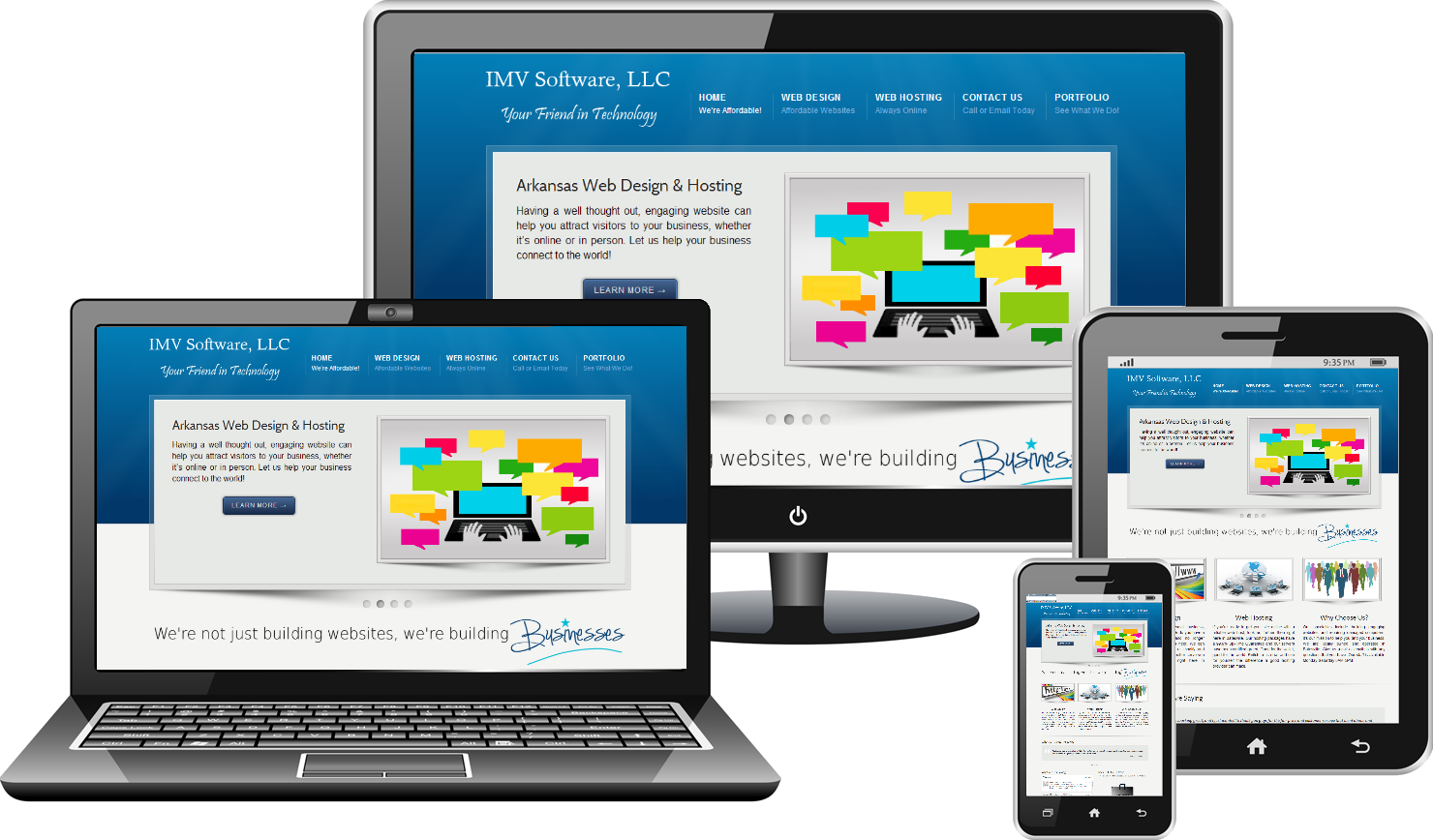Новое меню и экран многозадачности
Новое меню приложений от Google получило название App Drawer (ящик с программами). Приложения отображаются в алфавитном порядке и сортируются (профиль использования: на работе или дома).
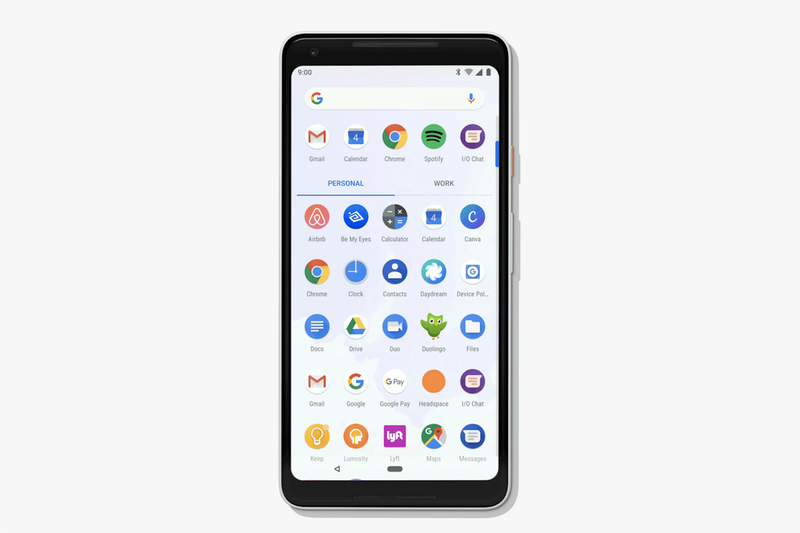
Новый экран многозадачности – Overview (Обзор) – имеет строку поиска и список приложений, предложенных системой.
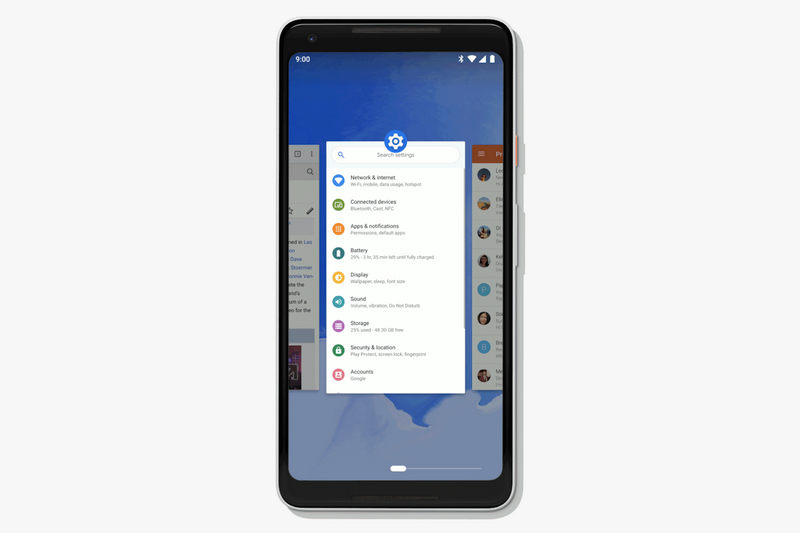
Он составляется на основе данных о поведении пользователя. Машинное обучение пошло Android P на пользу: система предугадывает (по крайней мере, пытается), какие программы пользователь захочет открыть следующими. Отметим тот факт, что окна приложений на экране многозадачности остаются интерактивными.
Метод 2: перепрошивка полного заводского образа через Fastboot
Если у вас разблокирован загрузчик, вам необходимо прошить полный заводской образ Android 12 Developer Preview через Fastboot. Обычно это делается через flash-all.sh или же flash-all.bat файл сценария, который включен в загруженный файл, но его конфигурация по умолчанию также полностью стирает устройство. Однако вы можете сохранить свои данные, удалив атрибут очистки «-w» из команды в сценарии.
- Загрузите файл заводского образа .zip на свой компьютер отсюда.
- Необязательно, но рекомендуется: проверьте контрольную сумму SHA-256 загруженного файла, чтобы убедиться, что файл был загружен полностью и правильно.
- Извлеките файл .zip, скопируйте и вставьте полученные файлы в папку ADB и fastboot на вашем компьютере для удобства.
- Необязательно: результирующие файлы будут содержать flash-all.sh или же flash-all.bat файл сценария. Используя текстовый редактор, откройте flash-all.sh если вы используете macOS / Linux или flash-all.bat файл сценария, если вы работаете в Windows. Найдите и удалите / удалите флаг -w в команда. Это позволит пропустить очистку данных на вашем телефоне. Тем не менее, чтобы избежать проблем с совместимостью, рекомендуется стереть данные.
- Включите USB-отладку на вашем телефоне — перейдите в «Настройки»> «О телефоне»> 7 раз нажмите «Номер сборки», (необязательно) введите свой шаблон, PIN-код или пароль, чтобы включить параметры разработчика, а затем перейдите в «Настройки»> «Параметры разработчика»> «Включить отладку по USB». ».
- Подключите телефон к компьютеру. Авторизуйте подключение к компьютеру на телефоне, когда на телефоне появится соответствующее сообщение, если это первый раз, когда вы подключаетесь к этому компьютеру ADB.
-
На вашем компьютере запустите:
Это перезагрузит ваш телефон в режим Fastboot.
-
На вашем компьютере Mac / Linux запустите:
Эта команда выполняет flash-all.sh файл сценария, который затем установит необходимый загрузчик, прошивку основной полосы частот и операционную систему. Если вы работаете в Windows, вы можете просто дважды щелкнуть файл flash-all.bat.
- После завершения сценария ваше устройство перезагрузится в новую ОС.
Обязательно следите за нашим тегом Android 12, чтобы быть в курсе всех последних новостей о следующей основной версии Android!
Чтобы использовать AlarmManager, нужно получить разрешение
Выполнение операции в заданное время в Android — боль любого разработчика. Чаще всего для этого используется AlarmManager. Но каждый из вендоров делает свои оптимизации энергопотребления и, как следствие, роботы AlarmManager’а. Поэтому в каждом лаунчере могут быть свои настройки для этой опции. Из-за этого часто приходится делать для каждого типа устройств инструкцию, объясняя как включить или отключить эту опцию.
В Android 12 появляется новое разрешение: schedule exact alarm. Без его получения теперь невозможно будет создать alarm в AlarmManager’е. Если такое разрешение не получить заранее, то будет выбрасываться SecurityException. При этом приложения должны использовать новые алармы только если это является критическим функционалом. Например, если это будильники или таймеры. А также приложение, которое содержит функционал с требованием, будет вызываться в точное время.
Связь в Android 11 Developer Preview
Если у вас есть приложение для проверки вызовов, теперь вы сможете получать статус проверки STIR / SHAKEN для входящих вызовов и настраивать предоставляемые системой экраны после вызова, которые позволяют пользователям легко помечать вызовы как спам и выполнять другие действия.
В API предложений Wi-Fi появились новые функции для приложений управления WiFi и других инструментов. Например, разработчики теперь могут принудительно отключаться, удаляя предложения по сети, и получать более подробную информацию о качестве соединения.
Улучшения Passpoint приведут в исполнение и уведомят об истечении срока действия профилей Passport. API предложений Wi-Fi теперь включает возможность управления сетями Passpoint.
камера
ImageDecoder API теперь поддерживает декодирование и рендеринг анимации последовательности изображений из файлов HEIF, что позволяет использовать высококачественные ресурсы с минимальным влиянием на сетевые данные / размеры APK. Использование decodeDrawable на источнике HEIF позволит разработчикам показывать высокоэффективные последовательности изображений HEIF в приложениях, как и GIF. Если источник содержит последовательность изображений, будет возвращен AnimatedImageDrawable.
API Native Image Decoder для NDK будет поддерживать кодирование и декодирование файлов изображений из собственного кода для графики и последующей обработки. Это устраняет необходимость во внешних библиотеках, сохраняя размеры APK.
Новые API также позволяют разработчикам отключать вибрации и уведомления во время активных сеансов записи. Теги метаданных теперь позволяют использовать режимы bokeh для запросов захвата камеры на совместимых устройствах.
Поддержка камеры теперь доступна в эмуляторе Android как для задней, так и для передней стрелок.
Медиа Потоковое
Декодирование видео с низкой задержкой в MediaCodec возвращает первый кадр потока, как только он готов; критическая функция для таких сервисов, как собственная Stadia от Google. Новые функции API позволяют приложениям проверять и настраивать воспроизведение с низкой задержкой для определенных кодеков.
HDMI режим с низкой задержкой
Оптимизация расхода аккумуляторной батареи
Google намерена улучшить автономность смартфонов на Android P с помощью машинного обучения. Разработка называется Adaptive Battery (Адаптивный аккумулятор). И она позволяет системе определять приоритеты приложений, в зависимости от того, как часто их открывает пользователь.
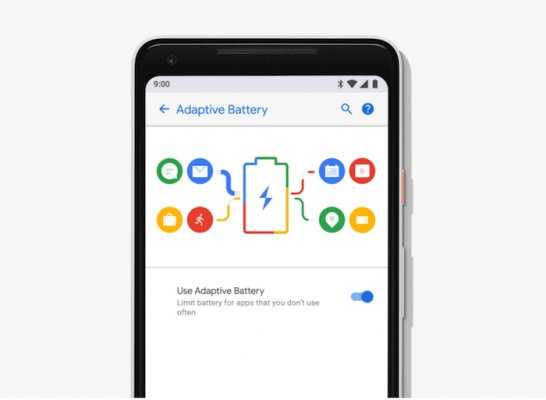
Многие изменения Android P несут благородную цель – упрощение работы с системой. Помогает в этом искусственный интеллект. Некоторые функции P’шки имеют приставку «адаптивный». Например – адаптивная батарея. Так, система сама определяет, какие приложения используются редко, а какие – часто, правильно расставляя приоритеты их фоновой активности. И это должно положительно отразиться на автономности смартфонов. Ожидают ее прирост минимум в 30%
Так, если приложение редко используется, через время оно будет закрываться. И смартфон в фоне будет терять меньше ресурсов. В то же время программы, которые используются чаще, в фоновой работе будут иметь приоритет. Инженеры уверены, что такая система сможет улучшить автономность гаджетов минимум на 30%.
Кроме того, машинное обучение в новой ОС поможет понять, как пользователь в зависимости от своего окружения меняет яркость дисплея, что позволит системе делать это самостоятельно.
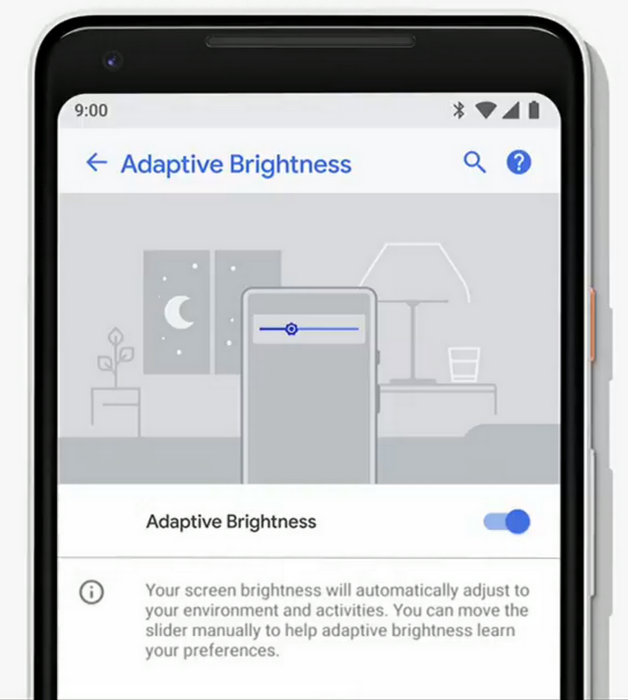
Новое адаптивное управление яркостью экрана должно сделать использование гаджета более комфортным и снизить его энергопотребление. Искусственный интеллект автоматически отрегулирует яркость экрана, основываясь на наблюдениях о том, как и когда это делает пользователь
Гибернация приложений
Если пользователь долго не взаимодействует с вашим приложением, например, несколько месяцев, то система сбросит все полученные разрешения и отправит его в . Что это значит:
- кэш будет очищен,
- приложение не сможет запускать джобы или алерты в фоне,
- приложение не будет получать пуши, включая high priority-пуши.
После одного взаимодействия с вашим приложением все ограничения будут сняты. Но разработчику нужно будет заново создать джобы, алармы и все уведомления, которые необходимы. Поведение схоже с тем, когда пользователь принудительно останавливает приложения в настройках (Stop application).
Compatible Media Transcoding
In Android 12, the ability for any application to play modern video formats appears. Android will be able to convert HEVC (H.265) to AVC (H.264) as well as HDR10 to SDR. You need to create a new XML file in your application resources describing support for modern formats, and then add a link to it in the AndroidManifest.
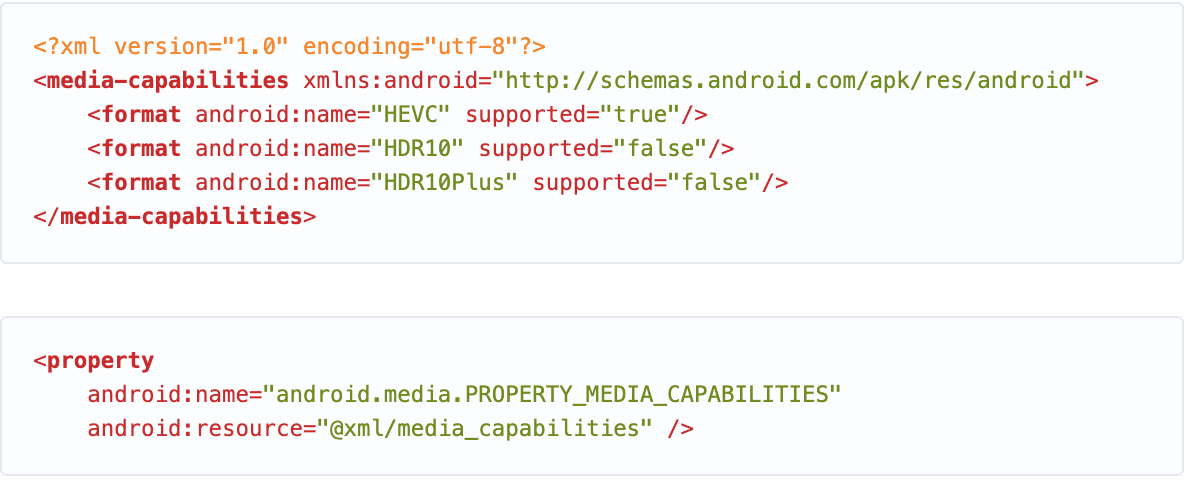
The new feature allows devices to create videos in modern formats on devices and convert them automatically so that there are no problems with using such content for applications.
The video conversion speed is fast — a one minute video at 1080p and 30 frames per second converts in 9 seconds on a Pixel 4. Let me remind you that the Pixel 4 has the flagship Snapdragon 845 processor and 6GB of RAM. Therefore, the results on devices with a class below may be worse(
Android 12 Developer Preview 2: What is your favorite new feature?
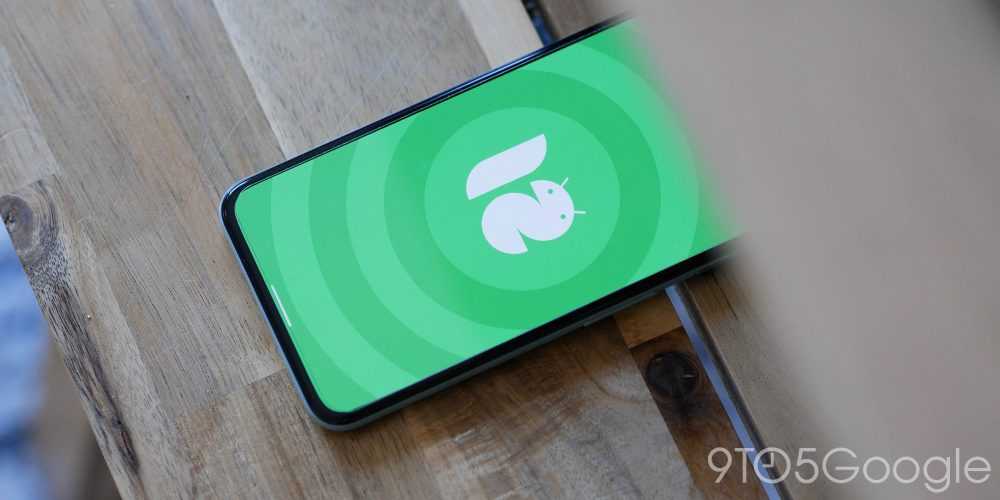
There are more than just surface-level changes in the Android 12 Developer Preview 2, making this fairly small selection the likely tip of the iceberg. With that said these are the most prominent user-facing features that we’ve found after delving in. Naturally, we expect to see more little things that might slip through the cracks over the coming days and weeks. We have a deeper dive into everything that has been added, including some features that require a little work to get fully operational in our full overview.
What is your favorite new feature or features? Let us know down in the comments section below!
More on Android 12:
Android 12 Developer Preview 1 hands-on: Top new features
FTC: We use income earning auto affiliate links.
Check out 9to5Google on YouTube for more news:
Step 1: Activate these three settings on your Android phone
- Enable the Developer Options menu in your phone. First, open the Settings app. For phones running Android 8 (Oreo), click System. Otherwise, if your phone has Android 7 (Nougat) or later, scroll down to About Phone, then find Build Number. Tap Build Number seven times to enable Developer Options.
- Turn on USB debugging (this lets your phone and computer communicate via USB) within the Developer Options menu. To do this, head to Settings > System > Advanced > Developer Options. You’ll find USB debugging with just a little scrolling down.
- Enable OEM unlocking. This option is also part of the Developer Options menu, further up the page than where you found USB debugging. If that option isn’t available for you to enable, that might be because it’s already enabled.
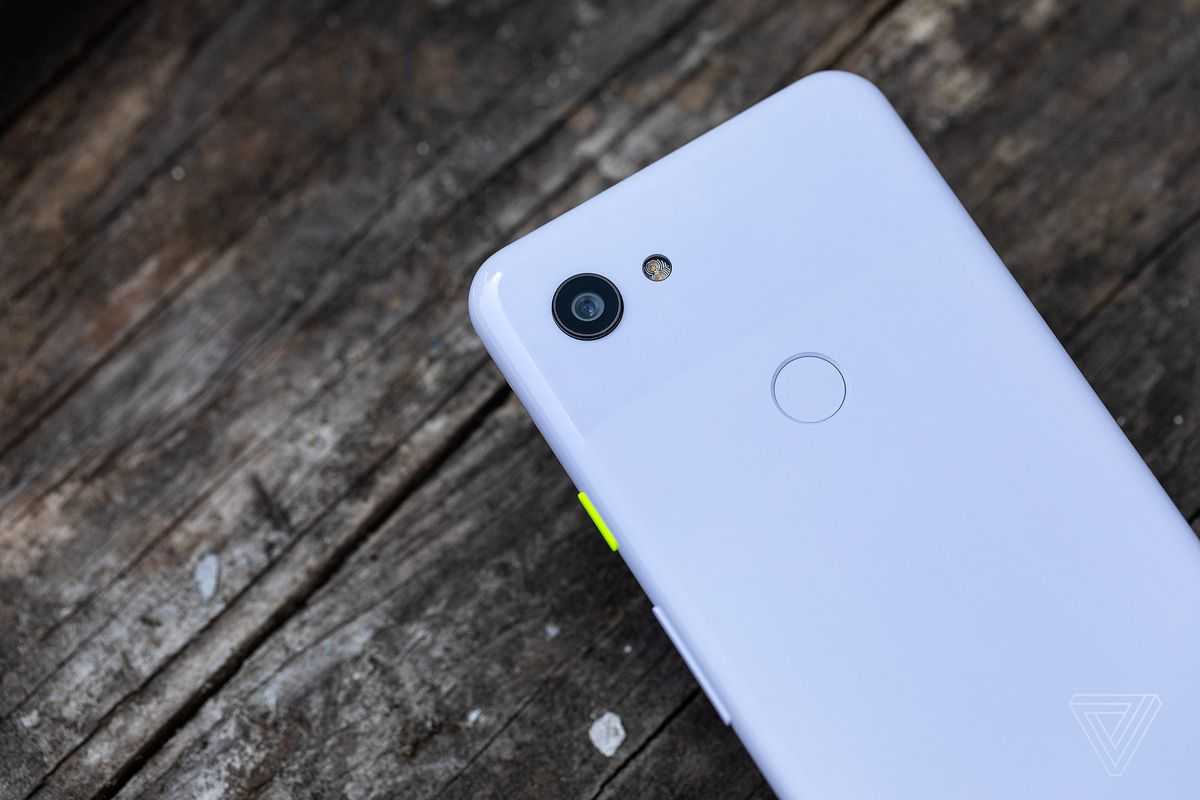 Photo by Vjeran Pavic / The Verge
Photo by Vjeran Pavic / The Verge
Exported declaration for all components in Manifest
For all components in the AndroidManifest, you must now explicitly declare the value “android: exported=true|false”, which is responsible for making the component available to other applications. By default, the value of this attribute is false, but if at least one intent-filter is declared for the component, then the value will change to true. This vulnerability was used by cybercriminals, for example, in this way the Slack authorization was hacked.

If you have targetSdk=S, and some component doesn’t have the exported value declared, then the installation will not complete, and you will see a message in Logcat.

Android Studio 2020.3.1 Arctic Fox contains Android Lint checks so you don’t miss a thing. It’s important that third party libraries that contain the components are updated. Otherwise, you will need to use the Manifest Merger features and set the exported value yourself.
Other
Many interesting changes have happened in Android 12, but I can’t tell you about all the changes in this video, so catch more changes in the quick format:
- ART is now updated regardless of the system
- In the standard Build class, new constants have appeared that allow you to get the chip manufacturer and its model (details).
- New App Standby bucket has appeared — Restrictive. It will be the strictest and most restrictive.
- Bouncy Castle cryptographic algorithm implementations have been removed
- Backup and data recovery have been split between local (over-the-wire) and cloud backups, and the configuration options have been updated.
- The creation of any PendingIntent now explicitly involves specifying whether it is mutable or not
- PiP behavior improvements and new features
- Web intent will now open in the application if the application is approved by this domain. Use Android App Links, or open the system settings of the application and ask the user to add domain to the approved ones
- SameSite cookie support in WebView
- Private Compute Core is an OS-isolated environment for processing user data. For example, Smart Reply, which doesn’t have access to the Internet, and the source code is open. The idea is to process user data on the device without the possibility of leaking it somewhere.
- The ability for apps to automatically update other apps has been added. Previously, only Google Play could do this
Random Musings on the Android 12 Developer Preview 2
Each time Google releases a follow-on developer preview, I rummage through
the incremental API differences report,
the release notes,
and even the release blog post,
to see if there are things that warrant more attention from
developers. I try to emphasize things that mainstream developers might use but may not
get quite as much attention, because they are buried in the JavaDocs.
Just shy of a month after Developer Preview 1 was released, we got Developer Preview
2!
What Amuses Me
Google has gotten into a bit of a habit of soft-releasing certain changes. They
include the changes in the SDK, but do not talk about them in the announcements
and documentation. Then, when the next developer preview comes around, they start
touting the “new” stuff… even when it had been in the SDK already. So, you may want
to start by reviewing my Developer Preview 1 musings,
as I mention some things there that only formally got announced today, including:
-
Hiding application overlay windows
-
Secure lockscreen notification actions
-
App digest API
-
Keeping companion apps awake
And, as a result, these random musings will be a mix of stuff that is “really real”
here in DP2 and a preview of stuff that might get announced in DP3 in a month or so.
What I Apparently Missed For Years
I never noticed the
tucked away in the object. They have been around since Android 5.0;
Android 12 is improving them a fair bit, in terms of expected accuracy and relevance.
What Is Finally Getting Some Love
App widgets — which had been a moribund backwater for years — are getting
some updates. It’s almost as if competition matters or something.
But, we can
apparently ,
including .
A bunch of new methods were added for configuring particular elements
(e.g., ). We can
and .
And we can
and .
I thought app widgets might get replaced someday, but at least for now, Google
is trying to improve what we already have.
What Just Keeps Getting More and More Love
Notifications now have a .
Despite the description, based on other options,
this appears to be designed for VOIP apps or other apps that might raise a notification
representing an incoming call.
What Makes Me Wish I Knew More About Mobile Carriers
Apparently, .
Mobile carriers can “virtually divide their
networks in portions and use different portions for specific use cases; for example,
a corporation can have a deal/agreement with a carrier that all of its employees’
devices use data on a slice dedicated for enterprise use.” I am not well-versed in 5G,
but I am still surprised that I had not heard about this capability.
There is a new
to be able to “configure and manage Virtual Carrier Networks”. I am not an expert
in mobile networks, but this feels a bit like exposing Google Fi-like ability to
combine multiple networks into a seamless aggregate network.
What May Be Good or May Be Bad
There is ,
described as “allows an app to use exact alarm scheduling APIs to perform timing sensitive background work”.
I do not know if this means that the family of APIs will
now work better (good!) or if this means that you need a permission to be able
to use them even in their current state (less good!).
What Is Here Today, Gone Tomorrow
is deprecated. And the DP1 and
permissions were removed outright.
was added and deprecated… both in Android 12 DP2, if the docs are to be believed.
What Else Seems Interesting
Apps can now .
There may be ,
which, if true, is a nice safety enhancement.
There are now forms of ,
for being able to check a list of values at once.
We can now ask a what it is used for,
such as .
There is now a .
We can control the thumb and track icons used by a ,
as well as .
We now have .
Apps can .
There is a new .
that does… something with media metrics.
There are now an official system color palette.
We may be getting APIs for determining the status of individual batteries.
It’s unclear if this is for devices with multiple internal batteries or if
this is for some sort of external battery.
There may be
for enabling hardware-assisted memory tagging.
There may be new options for different types of app installs, such as
.
We now have
and .
— Mar 17, 2021
Picture-in-picture mode tweaks
The Picture-in-picture mode experience on Android has needed some work for a little while. With the Android 12 Developer Preview 2, we’re getting some enhancements to usability and a few extra controls.
You can “stash” a picture-in-picture window to the left or right side of your screen if you need or want to focus on another app or webpage. This even works for those without YouTube Premium – at least in this Developer Preview – meaning you can listen to video content while doing other things.
A single-tap of the window shows playback controls like play/pause, skip, and more. Double-tapping the window switches back and forth between a small window size and a larger one. Or if you’re looking for more refined window size controls, you can now use pinch-to-zoom to resize the window.
Android 12 DP2: Picture-in-picture rework brings new gestures, stashing
Настройка интерфейса
Настройка внешнего вида интерфейса Android 12
В Настройках для этого есть целый раздел «Обои и стиль», в который интегрировано приложение Обои от Google. Перед вами откроется множество категорий, в каждой из которых огромный выбор изображений для домашних экранов. А если не хотите выбирать, нажмите на кнопку в правом верхнем углу – операционная система будет каждый день ставить новые обои из этой категории.
В качестве цветовой гаммы по умолчанию выбираются Цвета обоев, где в зависимости от изображения предлагается от одной до четырёх цветовых палитр. Можно выбрать и Базовые цвета с четырьмя вариантами, после чего этот оттенок станет основным в автоматически созданной теме.
Настройки интерфейса Android 12
В этом же разделе есть опция Иконки на основе темы. Пока только в бета-версии, о чём говорит значок около настройки. Внешний вид иконок изменится в соответствии с темой, но пока это касается в основном стандартных приложений от Google. У этой функции большой потенциал, однако сейчас пометка «бета» полностью оправдана.
Остался и Тёмный режим – он также соответствует автоматически созданной теме и делает интерфейс светлым или тёмным. Почему-то эту настройку можно найти сразу в трёх местах: в разделах Обои и стиль, Дисплей и Доступность. В первом Тёмный режим просто включается, а в двух других можно задать расписание.
Separate permission for Nearby scanning via Bluetooth
If you wanted to scan a nearby device using Bluetooth in current versions of Android, you had to ask for permission to access the location, which sometimes confused users. But in Android 12 these permissions will be split into new ones: BLUETOOTH_SCAN and BLUETOOTH_CONNECT. BLUETOOTH_SCAN is used for access when searching for Bluetooth devices, and BLUETOOTH_CONNECT is used when you need to connect to already paired devices.
If you still need crawl-based location access, then requesting location access is indispensable.
Exact alarm permission
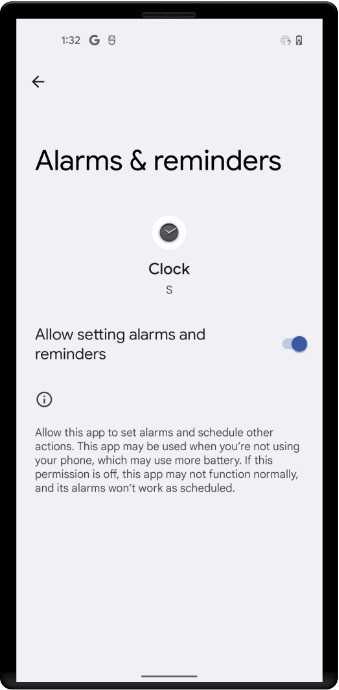
Performing operations at a given time is a pain for Android developers. Each of them makes their own power optimizations, which force each shell to disable them in its own way, and the application must show the instruction. Perhaps we will see an improvement in the work of accurate alarm triggering, since now the SCHEDULE_EXACT_ALARM permission will appear in the system, without which calls to exact alrams in the AlarmManager will throw a SecurityException.
The new permission is not a runtime, which means that the user will have to be sent to the system settings to get it.
Applications should use a new type of alarm if it’s critical functionality. For example, alarms or timers, as well as applications that contain functionality with the requirement to be called at the exact time. It’s possible that Google Play will not allow all applications.

Новая панель оповещений
С закругленными уголками и круглыми кнопками быстрых настроек, которые при длинном нажатии будут отправлять пользователя в основное меню настроек.
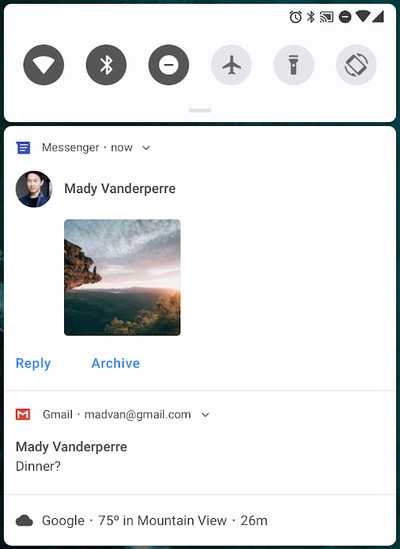
Кроме того, мессенджеры смогут отображать не только текст отдельных сообщений, а и часть переписки. И ее тут же можно будет продолжить (без открытия приложения).
Также приложения обзаведутся функцией автоматического ответа прямо из панели оповещений.
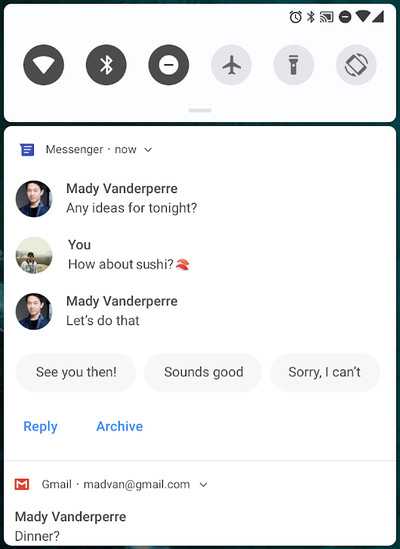
Ребята из Google обещают добавить машинное обучение при работе c оповещениями. И система сможет следить за тем, какие уведомления вы игнорируете и не открываете, отключая их через некоторое время.
What’s new in Android 12 Developer Preview 2
Trust and safety
- Allowing an app to overlay windows on top of other apps poses an obvious security risk. To that end, the new permission introduced in Developer Preview 2 ensures that an app can call to indicate that all windows should be hidden when the app’s window is visible.
- Notification visibility controls have been updated in this new preview release. Now you can configure notification actions so that they will always generate an authentication challenge when triggered from the lockscreen. For example, a messaging app now requires authentication before deleting a message or marking it as read.
- Android 12 Developer Preview 2 has added support for a simpler, more efficient way to obtain the checksum of an installed app. Developers can choose from several standard digest algorithms such as SHA256, SHA512, Merkle Root, and others. A backward compatible version of this feature is in the works, which should be available in the form of a Jetpack library in the near future.
New Android 12 API Changes
- Rounded corners: In Android 12 Developer Preview 2, developers can check if the device has a screen with rounded corners and get their details. From the perspective of UI design, one can now utilize the absolute details for each rounded corner as well as the corner details relative to an app’s bounds.
- Picture in Picture (PIP) improvements: Apps can now to let the system resize the PIP Activity when needed. In addition, enabling auto-PIP now makes the system directly transition the app to PIP mode on an up-to-home gesture, without waiting for the up-to-home animation to complete. Finally, Android now supports stashing the PIP window by dragging it to the left or right edge of the screen.
- Updates to companion device app API: Wearable devices like smartwatches and fitness trackers usually need a dedicated app for managing them. Google wants to make it easier for such apps to be running and connected whenever an associated companion device is nearby. To do that, Android 12 Developer Preview 2 has introduced a new CompanionDeviceService API. Moreover, the new greatly simplifies the companion device enrollment process.
- Bandwidth estimation improvements: Google has greatly enhanced the existing bandwidth estimation APIs. Developers can now get an estimate of aggregate throughput per carrier or Wi-Fi SSID, network type, and signal level, for all users on the device.
- Visual effects: Applying common graphics effects is now easier than ever in Android 12 with the RenderEffect class. You can now separately apply blurs and color filters, or combine these effects as chain effects as a whole.
You can go here to see the full API diff between Android 12 DP1 and DP2. Since Google has revamped several of the APIs, make sure to run and debug your app through the behavior change toggles to prepare it for targeting Android 12. Feedback can be given here.
It is recommended to read the release notes before you download and flash the update. Be sure to go here to file any bug reports and here to discuss the latest release.
Foreground Service notifications will be shown to you with a delay
How often do you see notifications that appear for a couple of seconds and disappear? Maybe you yourself made such notifications with your own code? An experienced developer knows that this is a Foreground Service that gets the job done quickly and therefore the notification shows up and disappears quickly. In Android 12, the notification associated with the Foreground Service will not show for the first 5 seconds. This improvement is UX focused and I hope it will be well received by users. Of course, there are exceptions to the rule, for example, if a notification has action buttons, it will be shown immediately. The developer can explicitly specify that the notification should be shown immediately using the new API in Notification.Builder.setForegroundServiceBehavior ().

Microphone and camera usage indicator
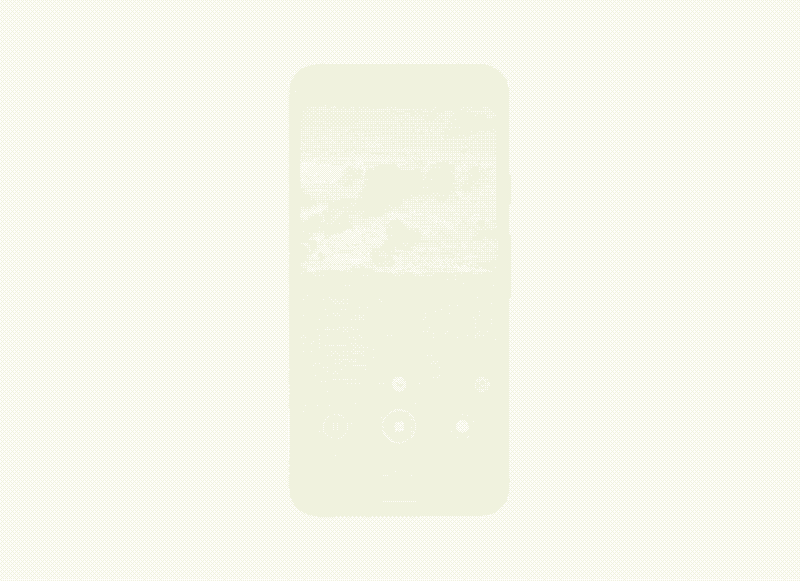
Modern versions of Android and iOS are actively borrowing ideas from each other, and the new system feature is implemented similarly to iOS. When applications use a camera or microphone, an indicator will appear in the status bar, which will not allow doing something in the background. Also, the user at any time can disable access to the camera and microphone for all applications using toggles.
Характеристики
Пользовательский интерфейс
Android 12 представляет собой серьезное обновление языка материального дизайна операционной системы, получившего название «Material You», который включает более крупные кнопки, увеличенное количество анимации и новый стиль для виджетов домашнего экрана. Функция с внутренним кодовым названием « monet » позволит операционной системе автоматически генерировать цветовую схему для системных меню и поддерживаемых приложений, используя цвета обоев пользователя. Зоны умного дома и кошелька, добавленные в меню питания на Android 11, были перемещены в тень уведомлений, а Google Assistant переназначен для удержания кнопки питания.
Android 12 также предлагает встроенную поддержку для создания скриншотов с прокруткой.
Платформа
Повышена производительность системных служб, таких как WindowManager, PackageManager, System Server и Interrupts . Он также предложит улучшения доступности для слабовидящих. Среда выполнения Android была добавлена в Project Mainline, что позволяет обслуживать ее через Play Store .
12 Android добавляет поддержку пространственного звука и звука MPEG-H 3D Audio (in) и будет поддерживать перекодирование видео HEVC для обратной совместимости с приложениями, которые его не поддерживают. API «вставки богатого контента» облегчит передачу текста и форматированного мультимедиа между приложениями, например, через буфер обмена .
Частная жизнь
Функции машинного обучения в операционной системе станут песочницей в «Android Private Compute Core», которому категорически запрещен доступ к сетям.
Приложения, запрашивающие данные о местоположении, теперь могут быть ограничены доступом к «приблизительным», а не «точным» данным о местоположении. К кнопкам быстрой настройки добавлены элементы управления, предотвращающие использование приложениями камеры и микрофона. Индикатор также появится на экране, если они активны.
Better support for rounded corners
This is more of an under-the-hood change than one you’ll notice in daily use, but beginning with Android 12 Developer Preview 2, developers can set their apps to check whether your device has rounded corners on its display, and optimize the UI accordingly. Through various classifications within the new APIs, they’ll even be able to see which corners are rounded, and whether different corners have different radii.
While this may not sound like much at first, if you’ve ever experienced text in the status bar or other objects being cut off by rounded corners, this step will help tidy things up in the future.
Контроль использования гаджета
Теперь Вы сможете посмотреть всю информацию о том, как Вы использовали ваш девайс: сколько времени потратили на те или иные приложения, сколько раз Вы разблокировали свой телефон, сколько уведомлений получили и т.д и т.п. Если сторонние разработчики подхватят использование этой технологии, то можно будет также рассматривать подобную статистику внутри приложений, например, общее время, потраченное на просмотр видео и так далее.
Также, теперь пользователь может ограничить время использования тех или иных приложений. Например, указать, что не желает тратить на Instаgram более 30 минут в день. Когда назначенный лимит будет достигнут, приложение попросту закроется, а его иконка до конца дня перекрасится в серый цвет.
Есть еще один режим, который также позволит избавиться от Вашей зависимости гаджета – Wind Dоwn. Суть его работы сводится к тому, что каждый день, когда Вы собираетесь ложиться спать, гаджет переходит в черно-белый режим. Опытным путем доказано, что в таком режиме Вы всё еще сможете спокойно, как и раньше, потреблять контент, но Вы просто не захотите делать это долго.
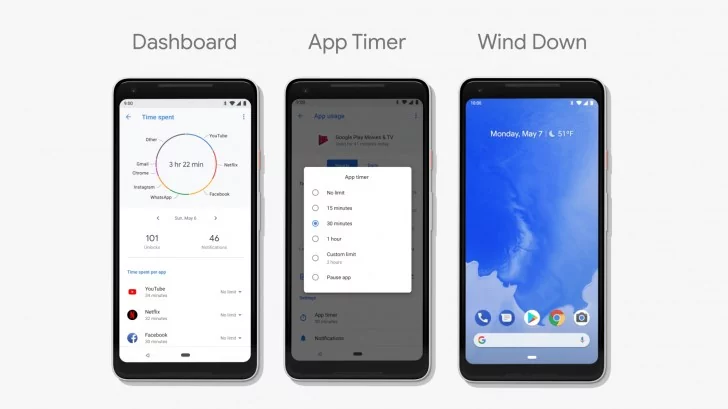
Игры, пасхалка и эмодзи
Игровой режим Android 12
Правда, функция будет доступна только в играх, где её реализовали разработчики. Google также добавила два игровых режима: с максимальной производительностью и экономией заряда аккумулятора.
Не обошёлся Android 12 и без традиционной пасхалки – в настройках зайдите в раздел О телефоне и несколько раз нажмите на версию Android. Посередине экрана появится гигантский виджет с часами. Причём сделан он в соответствии с подходом Material You – у него такая же тема, как у остального интерфейса.
Эмодзи Android 12
Если вы переходите на новый смартфон Pixel, все данные со старого девайса легко передать через кабель или по Wi-Fi, причём этот метод работает даже с iPhone. Также на Android 12 появилось много новых эмодзи и обновились все старые – здесь их более 1000.
Step 2: Connect your phone to your computer and get started
- If you use Windows 10, you’ll need to install this driver first for your phone to be recognized. People using macOS or Linux don’t need a driver.
- Connect your phone to your computer with a USB cable. Then visit this page to proceed.
- The Android Flash Tool will ask for permission to access ADB keys in a pop-up window, which is necessary to install software on your phone. You’ll need to tap “OK” to proceed with this process.
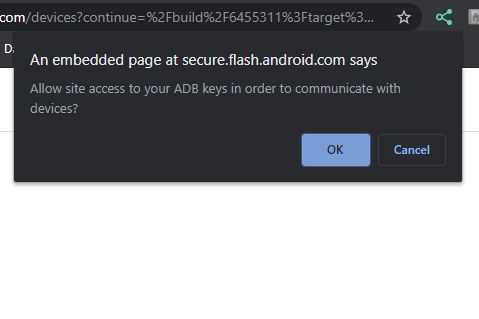
You’ll need to hit OK to proceed with the installation.
- Click “Select device.” Your device should appear in a pop-up window on your computer, so go ahead and click it.
- Once you do that, you should now see a request on your phone that says “Allow USB debugging?” You’ll also see a long string of numbers and letters that should match up with what your PC shows if you click the gear icon on the Android Flash Tool page. On your phone, check the box next to “Always allow from this computer,” then tap Allow.
- After that, your device should show up on the Android Flash Tool as being connected. Click on the box with the name of your device to proceed.
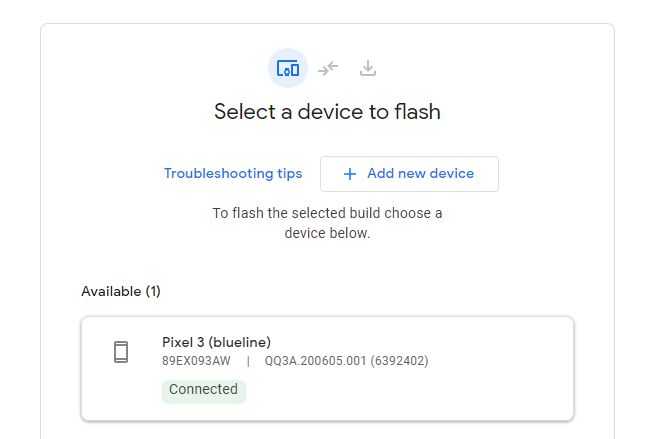
Once your device shows up as being connected, click into it.
You’ll want to pay attention to what appears in the “Selected build” section of the Flash Tool (see below). It should say “Android 12 Developer Preview 1.” Before you hit the blue “Install” button at the bottom of the page, I recommend tapping the pencil icon next to “Selected build” and checking the “Lock Bootloader” box. This will lock the bootloader after this process is complete, leaving you with a more secure device than if it remained unlocked.
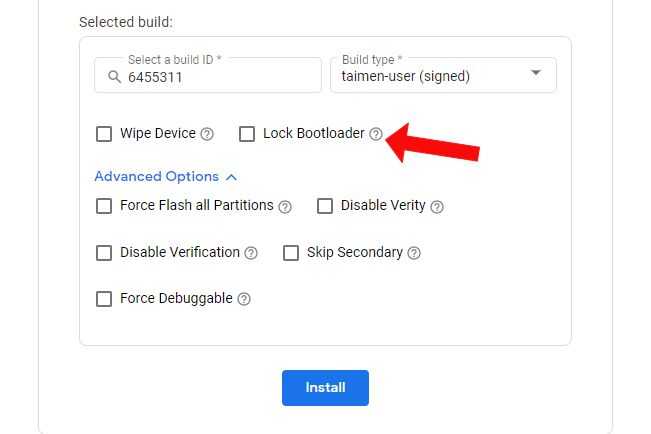
Select the “Lock Bootloader” option, which will lock your bootloader after the software installation is complete.
The next window basically tells you to stop interacting with your phone during the rest of this process unless asked to do so and to not unplug your device. If you’re in a position to proceed, go ahead.
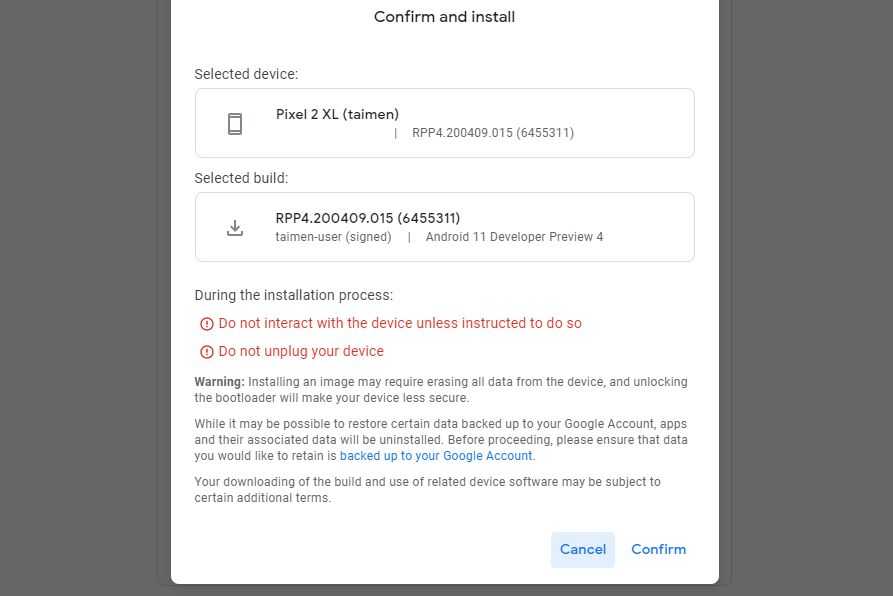
Make sure your data is backed up before you proceed.
- One more prompt before getting started: a license agreement. You need to agree to the terms of the Android Software Development Kit License Agreement, which you can find here.
- After you hit “I accept,” your phone will reboot into its bootloader screen. If nothing happens for a few seconds, don’t worry. You may also see a window pop up on your computer that says “Reselect your device.” In that case, leave your phone alone and select “Reselect device” on the computer. According to Google, your phone might be renamed “Android,” though it might just be identified with the model name (e.g., Pixel 3).
- If you haven’t flashed software before, Google will probably need to unlock your bootloader to proceed with the installation. Keep in mind that doing this will trigger a factory reset on your phone. If you haven’t backed up your data, you’ll lose everything. Once you agree, you’ll need to allow the bootloader to unlock on your phone. To do this, use the volume keys to navigate to the option that says “Unlock the bootloader,” then hit the power button once to confirm.
- After that, the Android Flash Tool will begin to download and install the software. You can continue to watch along, but don’t touch your phone at this point, even though it will restart several times. Just keep an eye on the progress using the Android Flash Tool page on your computer.
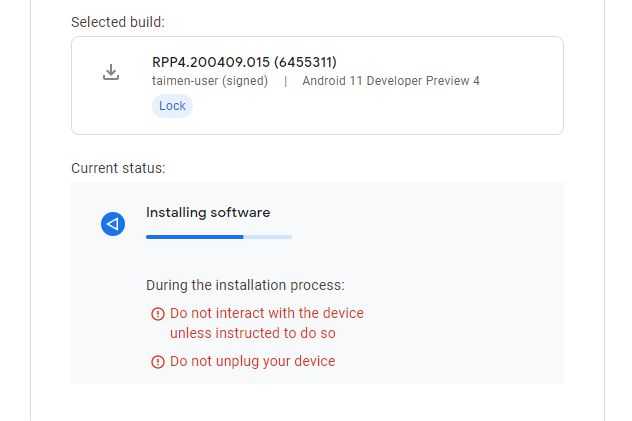
At this point, you can just sit and wait for the Android Flash Tool to wrap things up.
Once you’re all done, the phone will reboot one last time, and over on your PC, you’ll be met with a celebratory screen. You’re all done! And thankfully, you won’t have to go through this process again for the next Android 12 update — easy as this was. You’ll automatically receive updates to the developer preview over the air.
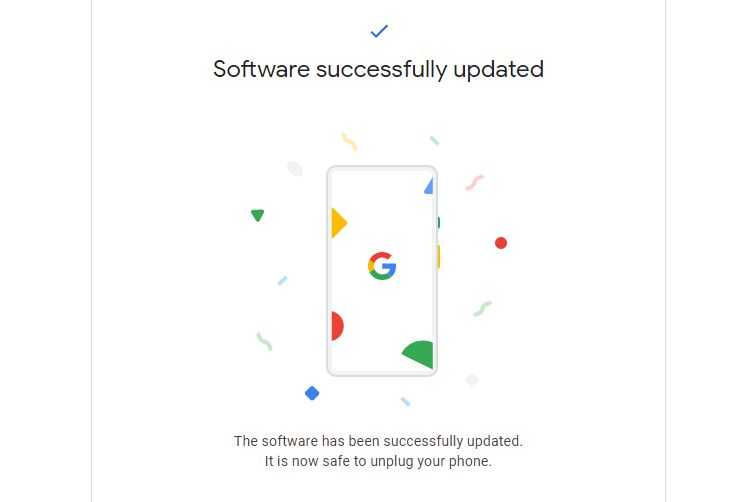
You’re all done!
